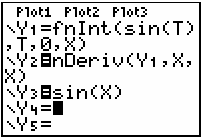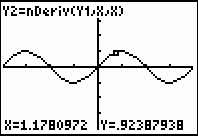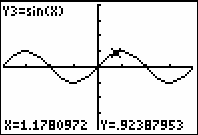A restatement of the Fundamental Theorem of Calculus is presented in this lesson along with a corollary that can be used to evaluate definite integrals analytically.
Restating the Fundamental Theorem of Calculus
You have discovered the Fundamental Theorem of Calculus in the context of finding areas under a curve but a more general version of this theorem can be proved without an appeal to area. The following is a restatement of the theorem.
If f is continuous on [a, b] and c is any constant in [a, b], then the function
![]() has a derivative at every point in [a, b], and the derivative is
has a derivative at every point in [a, b], and the derivative is
![]()
That is, the derivative of a definite integral of f whose upper limit is the variable x and whose lower limit is a constant equals the function f evaluated at x. This is true regardless of the value of the constant lower limit c. As long as c = a, x > a and f(t) is positive on [a, b], the function named F is the same as the area function that was previously explored.
Using the Restated Theorem
The restatement of the theorem may be used to evaluate  :
:
- Clear all functions and turn off all scatter plots in the Y= editor.
- Enter Y1 = fnInt(sin(T),T,0,X).
- Enter Y2 = nDeriv(Y1,X,X).
- Enter Y3 = sin(X).
- Unselect Y1.

- Select 7:ZTrig from the ZOOM menu.
- Trace on Y2 and Y3 to show the graphs appear to be the same.
 |
 |
|
|||
|
|
|||
18.3.1 Use the restatement of the Fundament Theorem of Calculus to evaluate
![]() , and then support your answer with the TI-83.
, and then support your answer with the TI-83.
Click here for the answer.
18.3.2 Predict the following derivative. Check your answer with the TI-83. Hint: You will have to use the chain rule.

Click here for the answer.
18.3.3 Evaluate the following derivative and support your answer with the TI-83.
![]()
Click here for the answer.
18.3.4 Find a more general version of the Fundamental Theorem of Calculus by predicting the following derivative.
![]()
Click here for the answer.
Using a Corollary of the Fundamental Theorem of Calculus
The following corollary of the Fundamental Theorem of Calculus gives a method for evaluating a definite integral.
Corollary
If f is continuous on [a, b], then
![]()
The function F is called an antiderivative of the function f.
18.3.5 Use the corollary to predict the value of
![]() , then check your work with the TI-83.
, then check your work with the TI-83.
Click here for the answer.
|
|||
|
|
|||